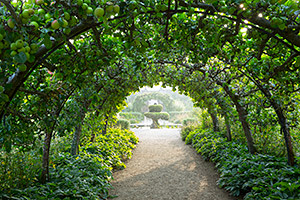The Prince of Wales’s organic principles in action at Highgrove


Roula Khalaf, Editor of the FT, selects her favourite stories in this weekly newsletter.
The Prince of Wales’s big garden at Highgrove in Gloucestershire is now 34 years old. The Prince is therefore one of Britain’s senior gardeners. What is the garden like and, in his busy life, how much does he know about gardening? In a video shown to the garden’s visitors, he explains that a garden “should feed the soul, warm the heart and delight the eye”. He says he is particularly keen to share the effect of his own garden with others. By appointment, I have just been down to share it.
I last saw Highgrove at what is now the halfway stage in its life. Seventeen years ago, on a sharp scenting day in January, I was one of the many keen foxhunters who followed a fast-moving fox from a nearby village covert into a tangle of uncut grass behind a prohibitive wire fence. “Why does the hunt not tell this farmer to take down the wire and clear up his fields?” I asked the lady on horseback beside me, as our horses paused for breath on one of the best hunting days I remember. “Robin,” she replied, “it’s Highgrove.” I had put the question to Camilla, then Camilla Parker Bowles.
There is still some rough grass at Highgrove and there may well be a wire perimeter fence. Further into the garden there has now been so much planting, subdivision and organic cultivation that foxhunters would not dream of intruding. In The Prince’s stated view, a “garden reflects a person’s soul”. The illuminating new book on Highgrove has a text by the designer Bunny Guinness, superb colour photos and a preface by himself about each month and what it means to him. In June, he is a lover of delphiniums, saying that he likes to see them standing “ramrod straight” in “noticeable platoons”, each one “at attention”. “They’re changing the canes at Buckingham Palace . . .” I found myself thinking. How does The Prince grow his own home Guard?

At Highgrove, The Prince insists on applying his principles, which are strictly organic. To him, my use of handy weedkillers like Roundup is a “quick-fix approach” that is out of harmony with the environment. For me, his use of knives and hoof-picks to lever weeds out from the flowery paving of his garden is a principle taken to extremes. He certainly expects what he preaches to be practised. With his expert head gardener, Debs Goodenough, I look at a recently cleared bed, planted with this year’s lobelias. She explains that she and the team had dug out the invading ground elder, smothered any bits left behind and, after one clear year, were at last able to replant. Organic gardening is so much more laborious, but I respect an apostle who actually carries it out. At Highgrove the garden team is 12-strong, full time.
We had entered the garden through a pair of carved Indian wooden door panels, a present to The Prince from his brother-in-law Mark Shand, before his recent untimely death. On the wall beside them was the headless carved bust of a topless Indian lady, another Shand present with which to welcome attentive gardeners. On the garden’s wall, stood the scented modern English rose, Jude the Obscure. At The Prince’s request the nearby chairs and seats have been painted a bright canary yellow to bring more light into the green surrounds. I would never have thought of that colour, but I would not have thought of the “page three” Indian sculpture, either.

By the façade of the house Goodenough shows me the colour scheme of this year’s container bedding. It is a bold mix of rose-red and clear yellow, prescribed by The Prince and “Tibetan” in effect, she explains. Verbenas and yellow flowered bidens, favourites of this column, are its mainstays in pots above masses of self-seeded alchemilla, which must be hard to control without chemicals. Beyond the paving runs the bold double line of clipped golden yew, some of which The Prince found in situ when he arrived in 1980. I would have taken it all out, but he boldly multiplied the idea and now leaves it, charmingly, to his gardeners to clip into topiary shapes of their own devising. Their novel forms stand above his famous long path of mixed types of flowering thyme, another challenge for organic maintenance. This year, Goodenough explains, golden marjoram is being introduced to pick up the gold colouring that the leaves of the clipped yews retain until late July. I spend a lot of time pulling out endless seedlings of my golden marjoram bushes, so the organic experts will be busy.

On the house I encounter the fine dark red climber Rose Highgrove for the first time. It has some scent, a long repeating season, excellent shape and a good resistance to disease except for some occasional mildew. Bred in 2009, it is usually on sale in the house’s accompanying plant centre and is the obvious memento to buy on a Highgrove visit. About 38,000 visitors now see the garden in pre-booked guided groups, but booking has to be done well in advance. All profits from the plant sales, produce and tickets are given to The Prince’s many charities.
The general plan has been to drape Highgrove’s façade heavily with climbers, including the big leaved Vitis coignetiae, the vine right by the front door. Beyond is the enclosed sundial garden which was one of the first to be laid out personally by The Prince. Here are the finest groups of his delphiniums, each of whose stems are indeed like ramrods, fixed to a cane. He likes groups of five or so, each in a different shade of pale to dark blue. I keep mine segregated, limiting each border to the paler shades only. “There are never enough delphiniums,” Goodenough tells me, even in the kitchen garden.

Most of the best gardens are a duet. Highgrove’s garden is appreciated by the Duchess of Cornwall but not much shaped by her. How, then, do The Prince and his head gardener interrelate? After training in Canada, at Kew and in the fine garden of Osborne on the Isle of Wight, Goodenough says wholeheartedly that “The Prince is still training me”. He is a constant source of ideas and someone with whom her new plants have to be discussed. She aptly points out that he has seen so many more gardens in the world than she ever has. I began to sense the “soul” behind this garden. It is influenced by global travel and multicultural style. In the manner of the southern hemisphere it includes a lush green planting of bananas (wrapped for protection in winter), huge gunneras and big ferns planted into the tops of tree stumps. This part of the garden, named Winterbourne after its stream, is not done full justice in photos. It has a lush effect under tall trees which is truly The Prince’s own idea.

Nor do photos do justice to the famous “stumpery” which the ingenious designer Julian Bannerman laid out for The Prince in imitation of an old Victorian idea. Some of its first tree-stumps even have a direct FT connection. They were presents from the Sussex park of the then Lord Cowdray, a major family-shareholder in the FT’s parent group Pearson. Sweet chestnut and oak, Goodenough explains, are the best stumps to use as they last so well. Annuals and ferns are planted into and around the stumps’ gaps.

On a wall leading into the big kitchen garden, I see the sculpted portrait busts of “worthies”, people of special importance to The Prince. I recognise Miriam Rothschild, champion of meadow wild-flower gardening which The Prince enjoys, and Vandana Shiva, the great environmentalist from India. Laurens van der Post is not visible, but to my amazement I think I see a bust of Lenin. “No,” Goodenough corrects me, “it is the Bishop of London.” Carved on the gateway are Egyptian hieroglyphics that read: “The stars in the sky are represented by the flowers of the earth.” I do not believe that ancient hot air for one moment. I believe that the flowers of Highgrove are sustained by Debs Goodenough and the stars in her 12-strong team.
Images extracted from ‘Highgrove: A Garden Celebrated’ by HRH The Prince of Wales and Bunny Guinness, Weidenfeld & Nicolson, £35
For individual and group garden tours of Highgrove, tickets can be bought online at highgrovegardens.com, or by ringing 020 7766 7310. All profits go to The Prince’s charities
Comments